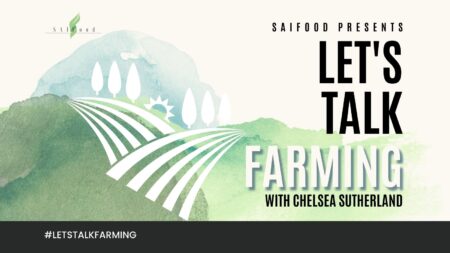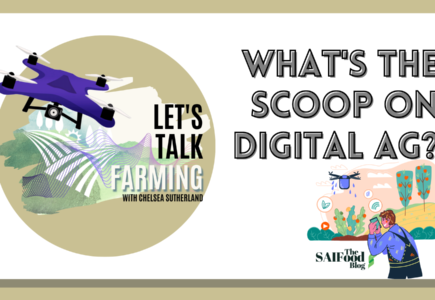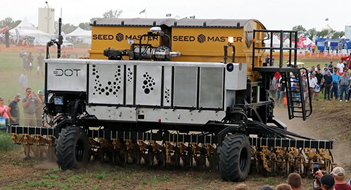Let’s Talk Farming Series
Saskatchewan farmers rely on a vast toolkit of technologies to produce their crops every year. Farming practices are always changing, and innovation and adoption of new technologies are vital to improving agricultural efficiency, productivity, and sustainability. This is the fourth in a series of blogs that will dive into some of the important technologies used by Saskatchewan farmers and discuss the current issues surrounding them. Check out the rest of the series, where I discuss fertilizer use, pesticides, and seeding.

What's the Scoop on Digital Ag?
A hot topic in agriculture right now is the expansion of digital ag. But what exactly is digital ag? At the broadest level, digital ag refers to the integration of digital technologies into the production of crops and livestock. However, digital ag refers to different technologies and opportunities depending on what segment of the agricultural supply chain you are in. For example, plant breeders, farmers, equipment manufacturers, and retailers will all use technologies in different ways to enhance and improve the efficiencies of their operations. Today’s post will focus solely on the opportunities and challenges digital ag provides for Canadian farmers.
Improved Farm Management
Farming is a business where you have to juggle seeding, pesticide, and fertilizer applications at the start of the growing season, and monitor for disease, insects, and harvest readiness throughout the season. It is no wonder that keeping track of it all can be overwhelming, as farmers are doing this on thousands of acres involving multiple crops. Through the years, farming families have come up with effective and creative ways to monitor, track, and record the applications and progress made on each field, including the use of binders, whiteboards, and spreadsheets.
The emergence of digital ag has provided farmers with exciting and user-friendly opportunities to monitor and manage their growing season data through software programs and apps. Some examples of these software systems include FarmCommand® by Farmers Edge, FarmLogic from TapLogic LLC, and AgExpert Field from Farm Credit Canada. Many of these systems are integrated with GPS and other software within the equipment, allowing for automatic and immediate updates to the farm management software while eliminating the need for manual entries. Other features often included in these farm management software systems are tracking of weather, equipment monitoring, market pricing reporting, and yield predictions.
Economic and Environmental Sustainability
Not only do various aspects of digital ag improve operational efficiencies for farmers, but they also contribute to improving both economic and environmental sustainability. Through soil testing, weather data, and crop imaging, maps can be created for farmers allowing for variable and precise application of fertilizer and chemical inputs. These maps can then be entered into the GPS systems in farm equipment, such as sprayers and seeders, which apply inputs at varying rates according to the map data. The use of these precise mapping technologies helps to reduce the overlap of inputs, minimizing both the economic cost of crop inputs for farmers and the loss of nutrients to the water and air.
Ag tech companies in this space offer numerous services including, but not limited to, soil testing, field mapping, field imaging, record keeping, and predictive crop analytics. Some companies offering mapping and other variable rate technologies to farmers include Echelon from Nutrien Ag Solutions, or more locally, SWATMAPS systems from Croptimistic Inc. based out of Naicam, Saskatchewan and PRS Cropcaster® from Western Ag based out of Saskatoon.
Artificial Intelligence
The expansion of artificial intelligence (AI) and machine learning systems in agriculture is contributing to the automation of activities that are currently completed by humans (i.e., soil sampling, crop scouting, and even equipment operation). Using robotics in place of human labour not only saves time and man-hours, but also provides an immediate and continuous information flow to the farmer through the associated software systems. Farmers can quickly respond to problems arising in their fields, such as disease or insect infestations.
The use of GPS autosteer systems in agricultural machinery has become quite common, allowing farmers to use their time in the tractor to pay bills, market grain, make phone calls, or simply turn on the radio and enjoy some hands-free time. The equipment steers itself, requiring only initial set-up and manual turning around at each end of the field. Beyond autosteer, the emergence of fully autonomous equipment provides further opportunities to save time and labour. These machines require farmers to drive them out to the field, but once they have arrived and are set up, farmers can exit the cab and let the equipment do the work. One example is the DOT system, introduced by SeedMaster and now owned by Raven Industries Inc. The DOT is a diesel-powered supply system that attaches to implements that have been adapted for pairing, making them autonomous. With increasing shortages in farm labourers, self-driving equipment may just find a place on farms across Canada.
Although these technologies make farming operations more efficient, they don’t necessarily make farming easy. Not only are there learning curves that come with all new technologies, but when something goes wrong, farmers need to have solutions in place or know who to contact to get things back up and running. Fixing problems with new tech is costly, whether that be monetarily to have equipment fixed at a dealership or shop, or if a farmer understands the tech enough and has the infrastructure in place to fix the equipment themselves, the cost of the labour hours required to learn, maintain, and fix new equipment is high as well. The bottom line is, even with the expansion of new technologies at farmers’ fingertips, farming is still not an easy job.
Data Privacy and Ownership Considerations
There is no question that the examples of ag technologies discussed above improve efficiencies for farmers and help improve the environmental footprint of agriculture. Yet, with the explosion of data collection in GPS and farm management software systems comes data ownership, privacy, and security concerns.
When equipment, weather, soil, crop production, and land use data is collected from one single farmer, this is referred to as “small data”. It can be helpful for the individual farmer as they track and monitor changes in production from year to year. When data from many farms is combined with data from other sources by technology providers, big data is created. Analysis of big data can provide economic and environmental recommendations. However, the collection, storage, and analysis of this big data causes concern for many farmers over the privacy of their personal data and raises questions about how it may be used and if it will be used without their permission. Farmers are also concerned about the potential for hackers to get into equipment software. As data is often collected automatically through farm equipment and sent to the equipment providers, ownership of operational data is also unclear and complex.
Some countries, including the United States, European Union, New Zealand, and Australia have introduced voluntary codes of practice for the use and sharing of agricultural data in response to farmers’ lack of trust in big data. Although Canada does not currently have codes of practice in place, some public policy options being considered in response to farmers’ concerns over big data are portability rights, which allow consumers to transfer their data from one software platform to another, or the creation of data co-operatives, allowing farmers to have some degree of ownership and control over their data.
The Future of Digital Ag
With the speed that technology continues to advance, there is no telling what the future of digital ag will be. The opportunities technology provides to improve agricultural efficiencies are endless. Yet, with rapid technological advances come concerns over the ethical implications of some uses of this technology. It is imperative that technologies be tested, used within security and privacy boundaries, and do not cause harm, or potential for harm, that outweighs the benefits. The bottom line is, if used correctly, the expansion of digital technologies in the agricultural industry provides tremendous opportunities to ramp up food production to feed the world’s population while simultaneously improving environmental and economic sustainability.



